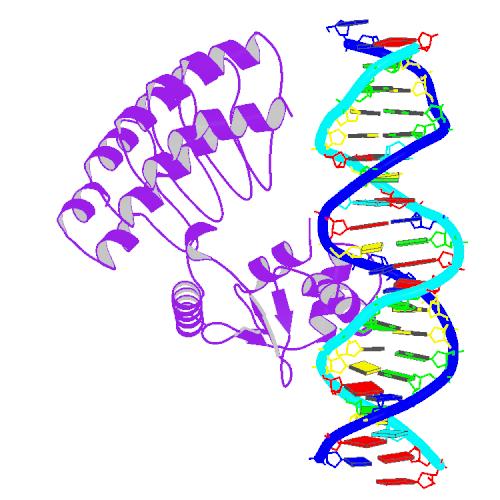GABPA
| GA binding protein transcription factor, alpha subunit 60kDa | |||||||||||||
|---|---|---|---|---|---|---|---|---|---|---|---|---|---|
 PDB rendering based on 1awc. | |||||||||||||
| |||||||||||||
| Identifiers | |||||||||||||
| Symbols | GABPA ; E4TF1-60; E4TF1A; NFT2; NRF2; NRF2A | ||||||||||||
| External IDs | Template:OMIM5 Template:MGI HomoloGene: 1543 | ||||||||||||
| |||||||||||||
| RNA expression pattern | |||||||||||||
 | |||||||||||||
| More reference expression data | |||||||||||||
| Orthologs | |||||||||||||
| Template:GNF Ortholog box | |||||||||||||
| Species | Human | Mouse | |||||||||||
| Entrez | n/a | n/a | |||||||||||
| Ensembl | n/a | n/a | |||||||||||
| UniProt | n/a | n/a | |||||||||||
| RefSeq (mRNA) | n/a | n/a | |||||||||||
| RefSeq (protein) | n/a | n/a | |||||||||||
| Location (UCSC) | n/a | n/a | |||||||||||
| PubMed search | n/a | n/a | |||||||||||
GA binding protein transcription factor, alpha subunit 60kDa, also known as GABPA, is a human gene.
This gene encodes one of three GA-binding protein transcription factor subunits which functions as a DNA-binding subunit. Since this subunit shares identity with a subunit encoding the nuclear respiratory factor 2 gene, it is likely involved in activation of cytochrome oxidase expression and nuclear control of mitochondrial function. This subunit also shares identity with a subunit constituting the transcription factor E4TF1, responsible for expression of the adenovirus E4 gene. Because of its chromosomal localization and ability to form heterodimers with other polypeptides, this gene may play a role in the Down Syndrome phenotype.[1]
References
Further reading
- Chrast R, Chen H, Morris MA, Antonarakis SE (1995). "Mapping of the human transcription factor GABPA (E4TF1-60) gene to chromosome 21". Genomics. 28 (1): 119–22. doi:10.1006/geno.1995.1117. PMID 7590737.
- Sawada J, Goto M, Watanabe H; et al. (1995). "Regional mapping of two subunits of transcription factor E4TF1 to human chromosome". Jpn. J. Cancer Res. 86 (1): 10–2. PMID 7737900.
- Gugneja S, Virbasius JV, Scarpulla RC (1995). "Four structurally distinct, non-DNA-binding subunits of human nuclear respiratory factor 2 share a conserved transcriptional activation domain". Mol. Cell. Biol. 15 (1): 102–11. PMID 7799916.
- Maruyama K, Sugano S (1994). "Oligo-capping: a simple method to replace the cap structure of eukaryotic mRNAs with oligoribonucleotides". Gene. 138 (1–2): 171–4. PMID 8125298.
- Watanabe H, Sawada J, Yano K; et al. (1993). "cDNA cloning of transcription factor E4TF1 subunits with Ets and notch motifs". Mol. Cell. Biol. 13 (3): 1385–91. PMID 8441384.
- Goto M, Shimizu T, Sawada J; et al. (1996). "Assignment of the E4TF1-60 gene to human chromosome 21q21.2-q21.3". Gene. 166 (2): 337–8. PMID 8543189.
- Sawa C, Goto M, Suzuki F; et al. (1997). "Functional domains of transcription factor hGABP beta1/E4TF1-53 required for nuclear localization and transcription activation". Nucleic Acids Res. 24 (24): 4954–61. PMID 9016666.
- Suzuki Y, Yoshitomo-Nakagawa K, Maruyama K; et al. (1997). "Construction and characterization of a full length-enriched and a 5'-end-enriched cDNA library". Gene. 200 (1–2): 149–56. PMID 9373149.
- Batchelor AH, Piper DE, de la Brousse FC; et al. (1998). "The structure of GABPalpha/beta: an ETS domain- ankyrin repeat heterodimer bound to DNA". Science. 279 (5353): 1037–41. PMID 9461436.
- Suzuki F, Goto M, Sawa C; et al. (1998). "Functional interactions of transcription factor human GA-binding protein subunits". J. Biol. Chem. 273 (45): 29302–8. PMID 9792629.
- Itoh K, Wakabayashi N, Katoh Y; et al. (1999). "Keap1 represses nuclear activation of antioxidant responsive elements by Nrf2 through binding to the amino-terminal Neh2 domain". Genes Dev. 13 (1): 76–86. PMID 9887101.
- Bannert N, Avots A, Baier M; et al. (1999). "GA-binding protein factors, in concert with the coactivator CREB binding protein/p300, control the induction of the interleukin 16 promoter in T lymphocytes". Proc. Natl. Acad. Sci. U.S.A. 96 (4): 1541–6. PMID 9990060.
- Sawada J, Simizu N, Suzuki F; et al. (2000). "Synergistic transcriptional activation by hGABP and select members of the activation transcription factor/cAMP response element-binding protein family". J. Biol. Chem. 274 (50): 35475–82. PMID 10585419.
- Guo A, Nie F, Wong-Riley M (2000). "Human nuclear respiratory factor 2 alpha subunit cDNA: isolation, subcloning, sequencing, and in situ hybridization of transcripts in normal and monocularly deprived macaque visual system". J. Comp. Neurol. 417 (2): 221–32. PMID 10660899.
- Vogel JL, Kristie TM (2000). "The novel coactivator C1 (HCF) coordinates multiprotein enhancer formation and mediates transcription activation by GABP". EMBO J. 19 (4): 683–90. doi:10.1093/emboj/19.4.683. PMID 10675337.
- Hattori M, Fujiyama A, Taylor TD; et al. (2000). "The DNA sequence of human chromosome 21". Nature. 405 (6784): 311–9. doi:10.1038/35012518. PMID 10830953.
- Galvagni F, Capo S, Oliviero S (2001). "Sp1 and Sp3 physically interact and co-operate with GABP for the activation of the utrophin promoter". J. Mol. Biol. 306 (5): 985–96. doi:10.1006/jmbi.2000.4335. PMID 11237613.
- Strausberg RL, Feingold EA, Grouse LH; et al. (2003). "Generation and initial analysis of more than 15,000 full-length human and mouse cDNA sequences". Proc. Natl. Acad. Sci. U.S.A. 99 (26): 16899–903. doi:10.1073/pnas.242603899. PMID 12477932.
- Dhakshinamoorthy S, Porter AG (2004). "Nitric oxide-induced transcriptional up-regulation of protective genes by Nrf2 via the antioxidant response element counteracts apoptosis of neuroblastoma cells". J. Biol. Chem. 279 (19): 20096–107. doi:10.1074/jbc.M312492200. PMID 14985350.
- Shen G, Hebbar V, Nair S; et al. (2004). "Regulation of Nrf2 transactivation domain activity. The differential effects of mitogen-activated protein kinase cascades and synergistic stimulatory effect of Raf and CREB-binding protein". J. Biol. Chem. 279 (22): 23052–60. doi:10.1074/jbc.M401368200. PMID 15020583.
| This article on a gene on human chromosome 21 is a stub. You can help Wikipedia by expanding it. |